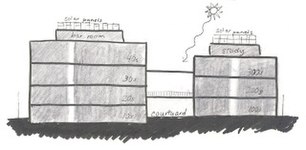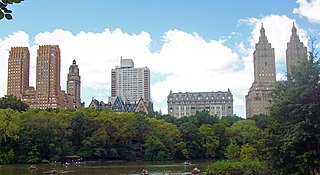
A housing cooperative, or housing co-op, is a legal entity, usually a cooperative or a corporation, which owns real estate, consisting of one or more residential buildings; it is one type of housing tenure. Typically housing cooperatives are owned by shareholders but in some cases they can be owned by a non-profit organization. They are a distinctive form of home ownership that have many characteristics that differ from other residential arrangements such as single family home ownership, condominiums and renting.

The Cloyne Court Hotel, often referred to simply as Cloyne, is a historical landmark in Berkeley, California and currently one of the houses of the Berkeley Student Cooperative (BSC), a student housing cooperative. It is located at the north side of the University of California, Berkeley campus at 2600 Ridge Road, near Soda Hall and Jacobs Hall, and is the next door neighbor of the Goldman School of Public Policy.
The Berkeley Student Cooperative (BSC) is a student housing cooperative serving primarily UC Berkeley students, but open to any full-time post-secondary student. The BSC houses and/or feeds over 1,300 students in 17 houses and three apartment buildings. Food is provided to residents of the 17 houses, which also offer boarding meal plans to non-residents. As part of their rental agreement, residents of the houses are required to perform workshifts, typically five hours per week. The BSC is led by a board of directors which is primarily composed of and elected by student members.

Kingman Hall is located at 1730 La Loma Avenue near the northeast corner of the University of California, Berkeley campus. As part of the Berkeley Student Cooperative, Kingman Hall houses 50 residents, known as Kingmanites or Toadies. It is named after Harry Kingman, the former YMCA director who in 1933 inspired 14 students to start a student cooperative. The house was designated a City of Berkeley Landmark in January 1999.
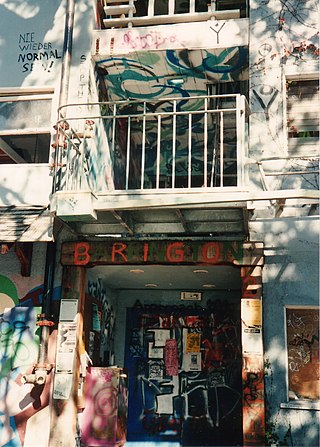
Barrington Hall was a student housing cooperative in the University Students' Cooperative Association (USCA) system in Berkeley, California, from 1935 to 1943 and 1950 to 1989. It is currently privately operated student housing.
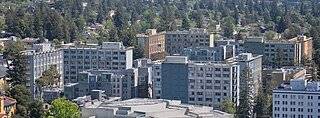
Housing at the University of California, Berkeley, includes student housing facilities run by the office of Residential and Student Service Programs (RSSP). Housing is also offered by off-campus entities such as fraternities and sororities and the Berkeley Student Cooperative (BSC).
A student housing cooperative, also known as co-operative housing, is a housing cooperative for student members. Members live in alternative cooperative housing that they personally own and maintain. These houses are designed to lower housing costs while providing an educational and community environment for students to live and grow in. They are, in general, nonprofit, communal, and self-governing, with students pooling their monetary and personal resources to create a community style home. Many student housing cooperatives share operation and governing of the house. As with most cooperatives, student housing coops follow the Rochdale Principles and promote collaboration and community work done by the members for mutual benefit.

The Two Dickinson Street Co-op, or 2D, is one of the five student dining co-ops at Princeton University in Princeton, New Jersey. 2D is a 50-member vegetarian cooperative located across the street from the Princeton University campus.

Lothlorien is a cooperative house consisting of two former mansions built next to the University of California, Berkeley, United States. It is located on 2405 and 2415 Prospect Street. Along with Kingman Hall, Casa Zimbabwe and Cloyne Court Hotel it is one of the well known houses in the Berkeley Student Cooperative system. Both buildings are considered to be significant for their architecture and location.
Spartan Housing Cooperative (SHC) is a nonprofit member owned and operated housing cooperative. The SHC was formed as in 1969, as a federation of existing student housing cooperatives in East Lansing. Since the first of the SHC's member houses formed 69 years ago, SHC has accumulated more than 4,000 members.
Rochdale Village is student housing cooperative apartment complex in Berkeley, California. The property is owned by UC Berkeley and leased by the Berkeley Student Cooperative (BSC). It was built during the late 1960s and early 1970s, with money loaned by the Department of Housing and Urban Development to the BSC. With approximately 260 residents, it is the largest housing co-op in Berkeley and one of the largest student housing cooperatives in the world. It lies at an elevation of 236 feet.
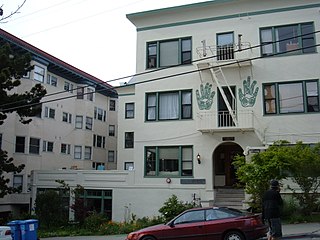
Stebbins Hall is a student housing cooperative owned by Berkeley Student Cooperative (BSC) and located at 2527 Ridge Road in Berkeley, California, on the Northside of the University of California, Berkeley campus. The house has a total occupancy of 64 residents during the school year, from late August to mid-May, and can accommodate upwards of 54 residents over the summer.

New Pioneer Food Co-op, commonly shortened to New Pi, is a locally owned food cooperative based in Iowa City, Iowa. This city also serves as the headquarters of the National Cooperative Grocers Association. New Pioneer has stores in Iowa City, Coralville, and Cedar Rapids as well as a production hub in North Liberty, Iowa.

The Oberlin Student Cooperative Association (OSCA) is a non-profit corporation founded in 1962 that feeds and houses Oberlin College students. Located in the town of Oberlin, Ohio, it is independent from but closely tied to Oberlin College. OSCA is one of the largest student housing cooperatives in North America, though membership has declined in recent years.
Media cooperatives are a form of cooperative that report on news based on the geographic location of their membership, or the general interests of the membership. Often they are a form of alternative media, critical of mainstream perspectives, with progressive society stances. However, several cooperatives outside of the West are established mainstream media outlets. Media cooperatives often unite customers and service providers to oppose a pure profit motive in the media. In contrast to mainstream media companies, media cooperatives are able to report independently, due to the minimization of the Principal–agent problem. Media cooperatives are growing in popularity as a form of organization for media reporting, however access to capital and lack of awareness in society present challenges to proliferation.

The University Cooperative Housing Association(UCHA) is a student housing cooperative in Westwood, Los Angeles near the University of California, Los Angeles (UCLA) campus. Able to house and feed over 400 members, the UCHA primarily offers housing to UCLA students, but welcomes members from any institution. The UCHA operates three buildings: Hardman-Hansen Hall (HHH or "Triple H"), Essene Hall, and Robison Hall. Jim Morrison of The Doors purportedly lived at the UCHA during his time at UCLA. Alongside the UCLA campus, Hardman-Hansen and Robison Halls were used as filming locations for the 1982 horror film, The Dorm That Dripped Blood. Many students of China's Lost Generation studying at UCLA resided at the UCHA.







